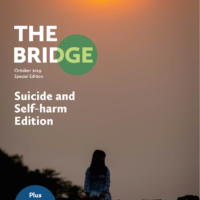Search results
-

Melatonin use and the risk of self-harm and unintentional injuries in youths with and without psychiatric disorders
Open Access paper from the JCPP – ‘This study investigated whether melatonin, which is the most common medication for sleep disturbances in youth in Sweden, is associated with a decreased risk of injury. Analyses were stratified by sex, injury type, psychiatric comorbidities and age at melatonin-treatment initiation’. Marica Leone (pic) et al.
Read more -

Suicide and Self-Harm Special Edition
The National Confidential Enquiry into Suicide and Safety in Mental Health Annual Report (2018) highlighted that suicide in the under 20’s is rising generally and that the number of suicides rises towards late teens.
Read more -

Suicide and Self-harm Edition Editorial
The National Confidential Enquiry into Suicide and Safety in Mental Health Annual Report (2018) highlighted that suicide in the under 20’s is rising generally and that the number of suicides rises towards late teens.
Read more -

In Conversation… Suicide and Self-harm with Professor Lars Mehlum
Lars discusses dialectical behaviour therapy for adolescents (DBT-A) as an intervention, his most recent paper in The JCPP, national strategies for suicide prevention and the latest clinical research.
Read more -

DBT-A reduces self-harming behaviours by improving feelings of hopelessness
Professor Lars Mehlum and colleagues have completed a prospective 3-year follow-up study, which showed that DBT-A has enduring effects in terms of reducing self-harm frequency in adolescents compared to EUC.
Read more -

Evidence Synthesis Studies, and Autonomic Dysregulation and Self-injurious Thoughts and Behaviour
In this Papers Podcast, Dr. Alessio Bellato discusses his JCPP Advances Special Issue Editorial ‘Evidence-based child and adolescent mental health care: The role of high-quality and transparently reported evidence synthesis studies’.
Alessio also co-authored a Research Review paper in the Special Issue entitled ‘Autonomic dysregulation and self-injurious thoughts and behaviours in children and young people: A systematic review and meta-analysis’, which will also be discussed.
Read more -

The TEENS randomised feasibility trial: Internet based intervention for non-suicidal self-injury in adolescents
In this Papers Podcast, senior researcher Dr. Britt Morthorst discusses her JCPP Advances paper ‘Internet based intervention (Emotion Regulation Individual Therapy for Adolescents) as add-on to treatment as usual versus treatment as usual for non-suicidal self-injury in adolescent outpatients: The TEENS randomised feasibility trial’.
Read more -

Self Harm – Pedagogy in practice
This free Self Harm session is exclusively for teachers and school leaders, and Chartered College of Teaching Members. ACAMH is delighted to have teamed up with the Chartered College of Teaching to present these FREE online training series entitled ‘Pedagogy in practice’.
- Event type
- Pedagogy in practice
- Location
- LIVE STREAM
-

Understanding Self-harm & Suicide – Ask the Expert
For this teacher and school leader exclusive session we are delighted to welcome Professor Dennis Ougrin to share his knowledge and insights into self-harm and suicide; specifically exploring the complexity around this phenomenon, by providing data on prevalence, risk factors and strategies for support.
- Event type
- Teachers and other Education Professionals
- Location
- LIVE STREAM
-

Understanding Self-Harm
TRIGGER WARNING: Please be aware that this blog discusses self-harm, including personal experiences of self-harm. It is estimated that between 10%-20% of all people self-harm at some point during their lifetime. It is hard to gather exact figures due to the stigma surrounding self-harm, and because people try to hide their wounds, scars and bruises. Watch this 8-minute film to understand more.
Read more
